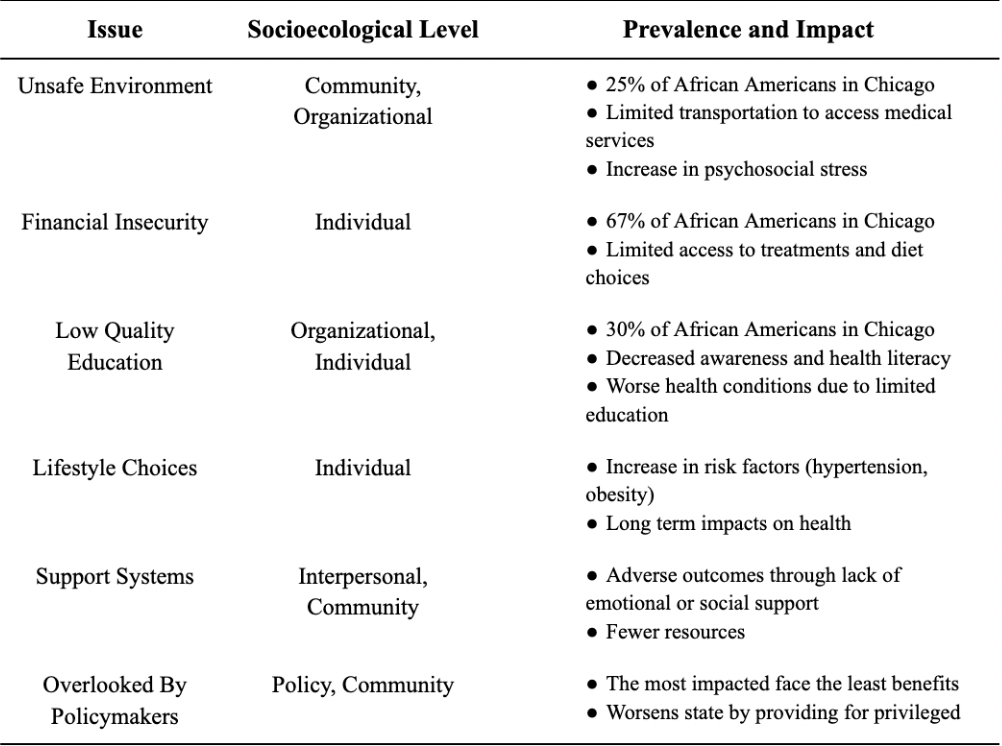This publication is in proud partnership with Project UNITY’s Catalyst Academy 2023 Summer Program.

Source: Marco Verch
Abstract
Background: Coronary Artery Disease (CAD) is the leading cause of mortality in the US. There is a lack of awareness on how to prevent CAD, as well as risk factors and social determinants of health (SDOH) that increase susceptibility to it, especially for the African Americans population. Objectives: The purpose of this review is to analyze and synthesize the various factors that contribute to the susceptibility of CAD within the African American community in Illinois and the U.S more broadly. By recognizing these key components, an effective public health intervention can be designed and implemented to minimize the effects of CAD. Methods: This review was conducted using PubMed, American Heart Association Journals, the Center for Disease Control and Prevention, and other scholarly sources relevant to the keywords. Over 110 pieces of literature were reviewed and synthesized. Results: The African American community is at the highest risk of CAD within Illinois and the United States due to biological, genetic, cultural, behavioral, and socioeconomic reasons. This includes hypertension, smoking, family history, segregation, redlining, and lack of quality healthcare in African American communities. Conclusion: Due to the various SDOH concerning African American communities, African American individuals are unable to receive the equitable quality healthcare needed to care for CAD, especially in Illinois. It is imperative for individuals to proactively initiate healthcare interventions that provide essential resources and education to empower the African American community.
Keywords: Coronary Artery Disease, African Americans, Social Determinants of Health, Prevalence and Risk Factors of Cardiovascular Diseases, Health Implications, Cardiovascular Health Interventions in Illinois.
Introduction
Coronary artery disease (CAD) is defined by plaque buildup in the coronary arteries, narrowing blood vessels and reduced flow of blood to the heart and body2. Although Cardiovascular Diseases (CVDs) have impacted the U.S. and Illinois greatly, CAD in particular has had the most detrimental impacts both nationwide and locally. African American individuals statistically have the highest mortality rate from CAD in the United States5, making it a significant public health issue. It is necessary to ensure that the large African American population in Illinois is protected from the effects of CAD, as African Americans compose 14.7% of the population, a large percentage compared to other states within the US8. From our Literature Review and Evidence-Based Research Review, our team was able to understand how and why the African American population is so heavily impacted by CAD: the various SDOH that affect African Americans, such as a relative lack of education, and their vulnerability to risk factors influenced by genetics and lifestyle choices. Although there are state-level initiatives within Illinois run the government and other organizations, it is imperative that more interventions are created to address the disparities that disproportionately affect the African American community.
This review analyzed over 110 existing articles through avenues such as PubMed, ScienceDirect, and Google Scholar to determine potential connections between CAD within the U.S. and Illinois, and the African American population. Our team engaged in discussion with representatives from the American Heart Association and Heart Smart EKG to create a plan of action to combat risk factors and SDOH specific to Illinois.
Across the United States, the African American community faces the highest rates of CAD. 20 million African American individuals in the U.S. have been diagnosed with CAD, and every year, African Americans account for 100,000 CAD deaths3. These numbers demonstrate the urgent need to address the various risk factors that contribute to these high death rates.
Genetic factors play an important role in increasing susceptibility to CAD. Certain genetic variants that increase the likelihood of dyslipidemia (high levels of cholesterol or fats) and hypertension (high blood pressure) are more prevalent in African American populations than other populations9. Cultural elements also factor into higher rates of CAD, such as traditional eating habits – for example, eating lots of ‘soul food’ which has high contents of fats and sugars – as well as attitudes towards exercise1.
Fortunately, the impacts can be mitigated. 90% of CAD diagnoses can be prevented through lifestyle changes such as improved nutrition and frequent exercise. But making these changes depends on knowledge of the various risk factors and how they can contribute to CAD6. A nationwide effort to spread awareness of these risk factors would be helpful for suppressing the high levels of CAD within the African American community.

Figure 1. Risk factors for CAD and their prevalence in the African American population (%).
Evidence-Based Research Findings
CAD trends are similar nationwide and in Illinois, the target region for our intervention, as African Americans face a 158.8% higher chance of mortality from CAD than any other race in Illinois alone7. Behind this much higher risk of mortality are various social determinants of health and risk factors present in Illinois, especially Chicago, that increase the threat of CAD.
The risk factors and determinants of health that contribute to CAD in the Illinois population can be curbed through the implementation of varying types of interventions. There have been numerous cardiovascular health interventions undertaken already in Illinois that apply to the levels of the socioecological model, which represents the various individual and environmental factors that determine an individual’s lifestyle and wellbeing. These include cardiovascular health lifestyle improvement programs, patient-provider communication improvement programs, awareness events, and governmental policies.
However, many interventions, especially lifestyle programs that involve a large time commitment, can be inaccessible to certain populations. There is currently no way to ensure a long-term positive impact on CAD risk for individuals in these populations. This motivated our team to reach out to stakeholders to further investigate gaps in CAD interventions in Illinois.

Table 1. Social Determinants of Health and Risk Factors for African Americans in Chicago.
Stakeholder Perspectives
We had the great opportunity of interviewing Kathy Aykroid, the director of the Max Schewitz Heart Smart Foundation, as well as Mya Gamble from the American Heart Association. Drawing on their experience with interventions for CAD, they shared some key considerations that helped us plan our own interventions. First, while most individuals do know what CAD is, they do not believe that it will affect them unless they have a direct connection to someone affected by the disease and see its implications in person. This means that programs that educate about the risks of CAD are much needed. For many populations, various intervention efforts and programs can be inaccessible due to the time commitment, transportation, or cost. Furthermore, many existing interventions lack consistent, long-term monitoring of participants, which is necessary for ensuring that participants see long-term reductions in CAD risk. We hope to address these concerns with our own intervention plans for improving cardiovascular health.
Plan of Action
Our interventions are strategically designed to be implemented at the different levels of the socioecological model and incorporate stakeholder insights. For our first intervention, we will host workshops in the Chicagoland area to promote health literacy at the organizational level. Our primary goal in the short-term is to target local elementary schools and plan engaging activities that educate students on CAD from a young age. In the month of August, we will run our first pilot curriculum at Highland Park Montessori.
As we understand the importance of education through our research, we hope to implement these prevention measures in children at a young age. In the month of October, we will continue to revise our curriculum through workshops in local schools, until we are confident it can excel at the community level.
Once this is accomplished, we will begin hosting workshops in community centers of downtown Chicago in November and December, specifically targeting African American communities. We will provide stations that teach attendees the importance of diet, exercise, and other health factors.
Understanding that many individuals lack a personal connection to CAD, we will have several professionals leading our sessions to build credibility. Through collaboration with our stakeholders like the American Heart Association, we will provide kiosks that offer blood pressure monitoring tools. As most existing CAD interventions are short-term and fail to follow up with communities, we have decided to implement a second intervention to combat this issue.
Our second intervention focuses on digital health and utilizing technology for long-term prevention. We will be creating an app and website that offer educational content on CAD detection. The app will contain tools that track vital signs, such as blood pressure, heart rate, and cholesterol levels. Additionally, it will offer personalized risk assessments based on user data to encourage individuals to seek medical attention if their risk profile suggests potential issues.
Since we know long-term adherence for individuals will be a challenge, through our app we hope to ensure individuals make long term lifestyle changes. Every attendee will have a full lifestyle plan easily accessible in the app.

Discussion
For a variety of reasons – including a comparative lack of access to CAD treatment and educational resources – African Americans are predisposed to CAD at levels far higher than the general population and experience much higher mortality rates.
This inequity poses dangerous implications for both the state of Illinois and the nation at large. With a history of discrimination and racism, it is essential to provide adequate care to help promote health equity today. Our intervention strategically takes into account the social determinants of health at play in Illinois, and current gaps in care. As we have learned from our stakeholders, existing interventions lack longevity, which is why we have implemented an app and website to work in conjunction with our workshops. This way, attendees can follow up and track their progress easily.
Although there are many strengths that come with our interventions, there are some limitations. Our team must overcome these issues to successfully implement these initiatives and gain the results we aim for in our communities. Possible limitations from our research include accessibility to a greater variety of journals/articles in our literature review. While we compiled adequate resources, we were limited to databases which don’t require fees. Another challenge in our research was finding specific data for the prevalence of CAD in African Americans within Chicago specifically, which was our target region for the interventions. There is currently a lack of literature on this issue.
Conclusion
Cardiovascular diseases are a critical public health issue and the leading cause of death worldwide. Heart disease accounts for one of the top causes of death in Illinois, impacting more than half its population4.
Combining interventions such as an app with a website, workshops, and educational programs for the youth population, will facilitate early detection and monitoring, lifestyle modification, and treatment adherence. These interventions will also forge positive community connections. After securing a solid foundation in Illinois, we plan on implementing our interventions in underserved communities nationally.
Further in-depth research is necessary to advance our knowledge on CAD and provide a better understanding of what challenges CAD patients currently face. This could include analyzing the effects of genetic factors through novel genetic markers and risk profiling. The effect of environmental pollutants and the gut microbiome on CAD could also be studied, as well as psychosocial factors, social support, and telemedicine.
Implementation of our interventions will improve CAD management, prevention, and patient outcomes, ultimately contributing to improved public health and reduced CAD mortality.
For the national literature review, see additional references at this link
References
- Carnethon, M. R. et al. (2017). Cardiovascular Health in African Americans: A Scientific Statement From the American Heart Association. Circulation 136, e393–e423.
- CDC. (2022). Coronary artery disease. Centers for Disease Control and Prevention https://www.cdc.gov/heartdisease/coronary_ad.htm.
- CDC. (2023). Heart disease facts. Centers for Disease Control and Prevention https://www.cdc.gov/heartdisease/facts.htm.
- Chronic diseases. https://dph.illinois.gov/topics-services/diseases-and-conditions/chronic-diseases.html
- Clark, L. T. et al. (2001). Coronary heart disease in African Americans. Heart Dis. 3, 97–108.
- Heart disease risk: How race and ethnicity play a role. Cleveland Clinic https://my.clevelandclinic.org/health/articles/23051-ethnicity-and-heart-disease
- Illinois heart disease and stroke prevention program. http://www.idph.state.il.us/heartstroke/cvd_aa_fs.htm
- United States Census Bureau > Communications Directorate – Center for New Media. QuickFacts: Chicago city, Illinois.
- Zilbermint, M., Hannah-Shmouni, F. & Stratakis, C. A. (2019). Genetics of Hypertension in African Americans and Others of African Descent. Int. J. Mol. Sci. 20.
Related Posts
According to New Research, Blue Whale Migrations Can Be Studied Through Song
Figure 1: A blue whale’s fluke (tail fin) sticks out...
Read MoreThe E.C.H.O. Initiative: Encouraging Cardiovascular Health Through Outreach
This publication is in proud partnership with Project UNITY’s Catalyst Academy 2023...
Read MoreRisk of Death Among Recently Released Inmates
Figure 1: While healthcare inequity is certainly an issue while...
Read MoreA Critical Evaluation of Strategies to Reduce Intergroup Prejudice
Figure 1: People group crowd Source: Pixabay Prejudice refers to an...
Read MoreHow the Bystander Effect on Security Robots can Hamper Law Enforcement
BigDog robots being tested under the supervision of a Boston...
Read MoreAre We Driving Our Dogs Sick Through Our Urban Lifestyles?
Figure 1: Allergic disorders in humans and dogs are associated...
Read MoreRia Agarwal, Dipikkasri Dhananjeyan, Akshaya Ganji, Smriti Kumar, Dhruv Malladi, Morish Shah






